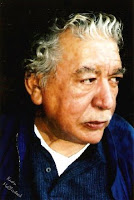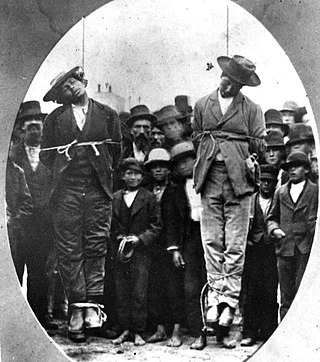
Chicano, Chicana, is an identity for Mexican Americans who have a non-Anglo self-image. Chicano was originally a classist and racist slur used toward low-income Mexicans that was reclaimed in the 1940s among youth who belonged to the Pachuco and Pachuca subculture. In the 1960s, Chicano was widely reclaimed in the building of a movement toward political empowerment, ethnic solidarity, and pride in being of indigenous descent. Chicano developed its own meaning separate from Mexican American identity. Youth in barrios rejected cultural assimilation into whiteness and embraced their own identity and worldview as a form of empowerment and resistance. The community forged an independent political and cultural movement, sometimes working alongside the Black power movement.

Cesar Chavez was an American labor leader and civil rights activist. Along with Dolores Huerta, he co-founded the National Farm Workers Association (NFWA), which later merged with the Agricultural Workers Organizing Committee (AWOC) to become the United Farm Workers (UFW) labor union. Ideologically, his world-view combined leftist politics with Catholic social teachings.

Gary Anthony Soto is an American poet, novelist, and memoirist.

Tiburcio Vásquez was a Californio bandido who was active in California from 1854 to 1874. The Vasquez Rocks, 40 miles (64 km) north of Los Angeles, were one of his many hideouts and are named after him.

Pachucos are male members of a counterculture associated with zoot suit fashion, jump blues, jazz and swing music, a distinct dialect known as caló, and self-empowerment in rejecting assimilation into Anglo-American society that emerged in El Paso, Texas, in the late 1930s. The pachuco counterculture flourished among Chicano boys and men in the 1940s as a symbol of rebellion, especially in Los Angeles. It spread to women who became known as pachucas and were perceived as unruly, masculine, and un-American. Some pachucos adopted strong attitudes of social defiance, engaging in behavior seen as deviant by white/Anglo-American society, such as marijuana smoking, gang activity, and a turbulent night life. Although concentrated among a relatively small group of Mexican Americans, the pachuco counterculture became iconic among Chicanos and a predecessor for the cholo subculture which emerged among Chicano youth in the 1980s.
Eduardo "Lalo" Guerrero was an American guitarist, singer and farm labor activist best known for his strong influence on later Latin musical artists.

Chicanismo emerged as the cultural consciousness behind the Chicano Movement. The central aspect of Chicanismo is the identification of Chicanos with their Indigenous American roots to create an affinity with the notion that they are native to the land rather than immigrants. Chicanismo brought a new sense of nationalism for Chicanos that extended the notion of family to all Chicano people. Barrios, or working-class neighborhoods, became the cultural hubs for the people. It created a symbolic connection to the ancestral ties of Mesoamerica and the Nahuatl language through the situating of Aztlán, the ancestral home of the Aztecs, in the southwestern United States. Chicanismo also rejected Americanization and assimilation as a form of cultural destruction of the Chicano people, fostering notions of Brown Pride. Xicanisma has been referred to as an extension of Chicanismo.

Tomás Rivera was a Mexican American author, poet, and educator. He was born in Texas to migrant farm workers, and worked in the fields as a young boy. However, he achieved social mobility through education—earning a degree at Southwest Texas State University, and later a Doctor of Philosophy degree (PhD) at the University of Oklahoma—and came to believe strongly in the virtues of education for Mexican-Americans.

Partido Nacional de La Raza Unida is a former Hispanic political party centered on Chicano (Mexican-American) nationalism. It was created in 1970 and became prominent throughout Texas and Southern California. It was started to combat growing inequality and dissatisfaction with the Democratic Party that was typically supported by Mexican-American voters. After its establishment in Texas, the party launched electoral campaigns in Colorado, Arizona, New Mexico, and California, though it only secured official party status for statewide races in Texas. It did poorly in the 1978 Texas elections and dissolved when leaders and members dropped out.

Juan Felipe Herrera is an American poet, performer, writer, cartoonist, teacher, and activist. Herrera was the 21st United States Poet Laureate from 2015 to 2017. He is a major figure in the literary field of Chicano poetry.
Mexican American literature is literature written by Mexican Americans in the United States. Although its origins can be traced back to the sixteenth century, the bulk of Mexican American literature dates from post-1848 and the United States annexation of large parts of Mexico in the wake of the Mexican–American War. Today, as a part of American literature in general, this genre includes a vibrant and diverse set of narratives, prompting critics to describe it as providing "a new awareness of the historical and cultural independence of both northern and southern American hemispheres". Chicano literature is an aspect of Mexican American literature.
Nash Candelaria was an American novelist. He was known for a tetralogy of novels about the Rafa family. He has been called the "historical novelist of the Hispanic people of New Mexico."

Their Dogs Came With Them is a 2007 novel by Helena Maria Viramontes. Viramontes was born in East Los Angeles, California, into a Mexican American family. She attended Garfield High School and later Immaculate Heart College where she earned her BA in English Literature. During her time in school, Viramontes became deeply influenced by the Chicano Movement. Their Dogs Came With Them is Viramontes most recent work. Seventeen years in production, Their Dogs is acclaimed for its complex characters and personal, gritty writing style. The novel is largely based on Viramontes's childhood in East Los Angeles. The book focuses on the freeway construction and difficult conditions for the Mexican Americans living in this area at the time. It also explores the formation of Chicano youth gangs and their impact on Chicano communities.

Luis Omar Salinas (1937–2008) was a leading Chicano poet who published a number of well-received collections of poetry, including the Crazy Gypsy, which has been described as "a classic of contemporary and Chicano poetry", I Go Dreaming Serenades, and Afternoon of The Unreal. He was awarded the Stanley Kunitz award by Columbia Magazine for one of his poems, and a General Electric Foundation Award. Salinas is regarded as "one of the founding fathers of Chicano poetry in America," with many of his poems being "canonized in U.S. Hispanic literature."
Juana Alicia is an American muralist, printmaker, educator, activist and, painter. She has been an educator for forty years. Juana Alicia, as part of the faculty Berkeley City College, founded and directed the True Colors Public Art program. Her sculptures and murals are principally located in the San Francisco Bay Area, Nicaragua, Mexico, Pennsylvania, and in many parts of California.
Jessie Lopez De La Cruz was a Chicano American farm worker, the first female recruiter for the UFW, an organizer and participant in UFW strikes, a community organizer, a working mother, and a delegate to the 1972 Democratic National Convention. She ran the first UFW Hiring Hall, was an adviser to the California Commission on the Status of Women, and the secretary treasurer of National Land for People. Lopez-De La Cruz is also known for her work banning the short-handled hoe, her work educating fellow farm workers, her work promoting co-op farming, and her commitment to fighting injustice for the working poor.
Las Mujeres Muralistas were an all-female Latina artist collective based in the Mission District in San Francisco in the 1970s. They created a number of public murals throughout the San Francisco Bay Area, and are said to have sparked the beginning of the female muralist movement in the US and Mexico. Their murals were colorful and large scale and often focused on themes such as womanhood, culture, beauty, and socio-political change. Patricia Rodriguez, Graciela Carrillo, Consuelo Mendez, and Irene Perez are recognized as the founders and most prominent members of the collective, but other female Chicana artists assisted along the way and even joined later on, such as Susan Cervantes, Ester Hernandez, and Miriam Olivo among others.
Rosalio Muñoz is a Chicano activist who is most recognized for his anti-war and anti-police brutality organizing with the Chicano Moratorium against the Vietnam War. On August 29, 1970, Muñoz and fellow Chicano activist Ramses Noriega organized a peaceful march in East Los Angeles, California in which over 30,000 Mexican Americans were in attendance to protest the war in Vietnam. The event became a site of police brutality after sheriffs attacked and tear gassed the crowd, leading to the deaths of three people, including Muñoz's friend and Chicano journalist Ruben Salazar.

Gringo justice is a sociohistorical critical theory developed by Chicano sociologist, lawyer, and activist Alfredo Mirandé in 1987, who used it to provide an alternative explanation for Chicano criminality in the United States and challenge the racist assumption that Chicanos were inherently criminal, or biologically, psychologically, or culturally predisposed to engage in criminal behavior. The theory is applied by Chicano and Latino scholars to explain the double standard of justice in the criminal justice system between Anglo-Americans and Chicanos/Latinos. The theory also challenges stereotypes of Chicanos/Latinos as "bandidos," "gang-bangers," and "illegal alien drug smugglers," which have historically developed and are maintained to justify social control over Chicano/Latino people in the US.
José Esquivel was a Chicano artist and activist based in San Antonio, Texas who was known for his work in challenging Anglo-American stereotypes of Mexican Americans and life in Chicano barrios. His work was connected to the Chicano Movement and it is included in various prominent collections. Esquivel was also a co-founder of the Con Safo art group.












